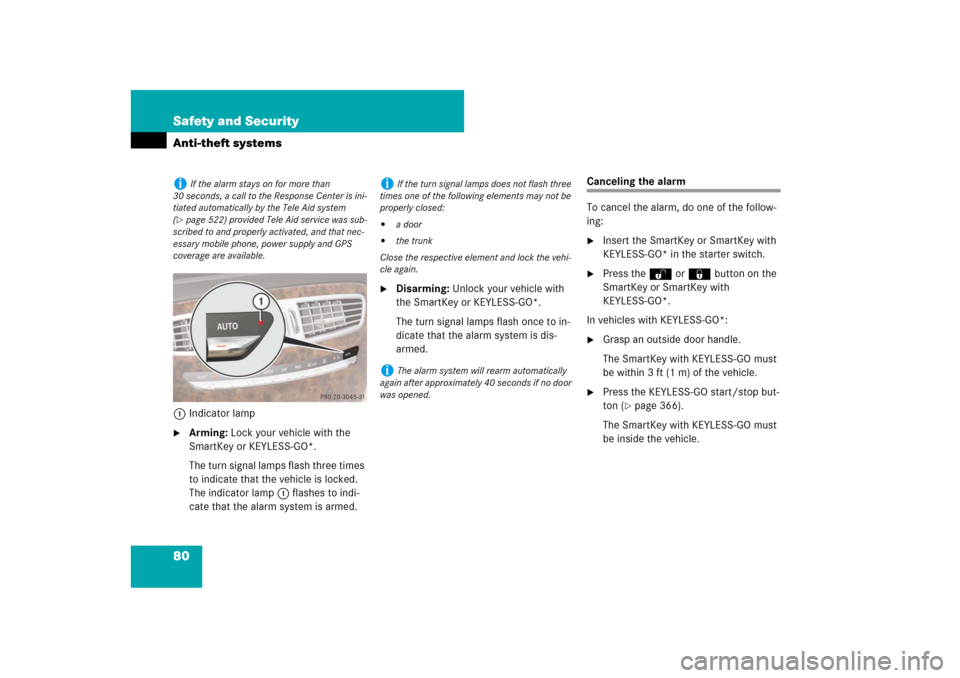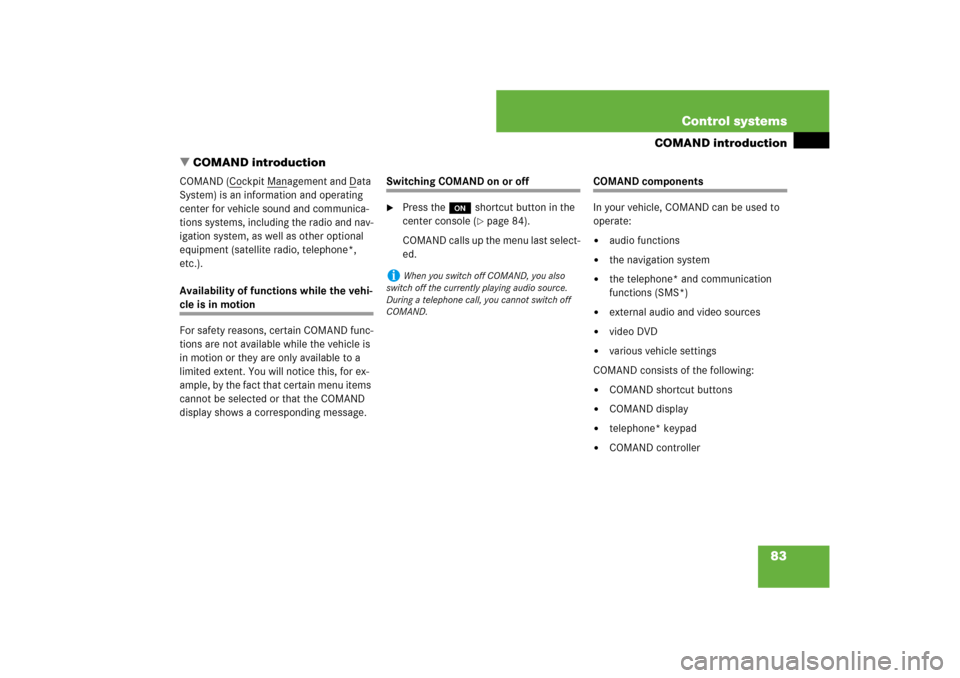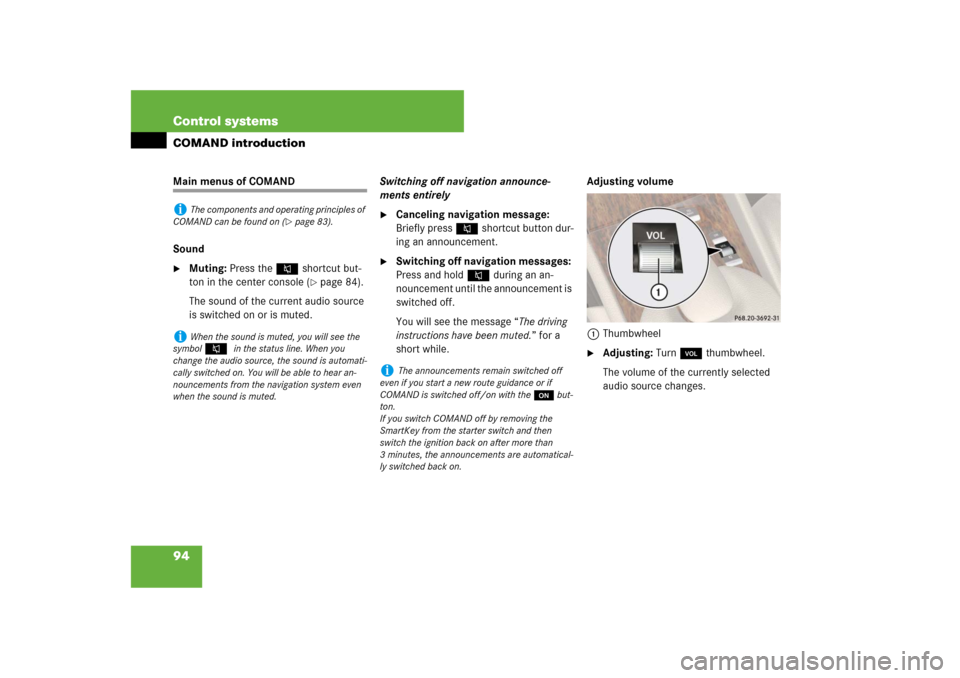Page 64 of 769

63 Safety and Security
Occupant safety
Blocking of rear side window operation
You can block the rear side window opera-
tion (for instance when you have children
riding in the rear passenger compartment).
The override switch is located on the door
control panel of the driver’s door.
1Override switch
2Indicator lamp
�
Activating: Press switch 1.
Indicator lamp2 comes on. The rear
side windows can no longer be operat-
ed using the respective switch located
in the rear trim panels.
�
Deactivating: Press switch 1 again.
Indicator lamp2 goes out. The rear
side windows can be operated using
the respective switch located in the
rear trim panels.
Warning!
G
Activate the override switch when children
are riding in the back seats of the vehicle.
The children may otherwise injure them-
selves, e.g. by becoming trapped in the win-
dow opening.
When leaving the vehicle, always remove the
SmartKey or SmartKey with KEYLESS-GO*
from the starter switch, take it with you, and
lock the vehicle. Do not leave children unat-
tended in the vehicle, or with access to an
unlocked vehicle. A child’s unsupervised ac-
cess to a vehicle could result in an accident
and/or serious personal injury.
i
Operation of the rear side windows with the
switches located in the driver’s door is still pos-
sible.
Page 65 of 769

64 Safety and SecurityPanic alarm1Â button
Activating�
Press and hold  button for at least
1 second.
An audible alarm and flashing exterior
lamps will operate briefly.
Deactivating�
Press  button again.
or
�
Insert the SmartKey or the SmartKey
with KEYLESS-GO* in starter switch.
or
�
Press the KEYLESS-GO* start/stop
button (
�page 366).
The SmartKey with KEYLESS-GO must
be inside the vehicle.
i
USA only:
This device complies with Part 15 of the FCC
Rules. Operation is subject to the following two
conditions:
(1) This device may not cause harmful interfer-
ence, and
(2) this device must accept any interference re-
ceived, including interference that may
cause undesired operation.
Any unauthorized modification to this device
could void the user’s authority to operate the
equipment.
i
Canada only:
This device complies with RSS-210 of Industry
Canada. Operation is subject to the following
two conditions:
(1) This device may not cause interference, and
(2) this device must accept any interference re-
ceived, including interference that may
cause undesired operation of the device.
Any unauthorized modification to this device
could void the user’s authority to operate the
equipment.
Page 72 of 769

71 Safety and Security
Driving safety systems
For more information, see “Practical hints”
section (
�page 614) and (
�page 622).
Warning!
G
Never switch off the ESP
® when you see the
ESP
® warning lamp v flashing in the in-
strument cluster. In this case proceed as fol-
lows:
�
While driving off, apply as little throttle
as possible.
�
While driving, ease up on the accelera-
tor.
�
Adapt your speed and driving style to
the prevailing road conditions.
Failure to observe these guidelines could
cause the vehicle to skid.
The ESP
® cannot prevent accidents result-
ing from excessive speed.
Warning!
G
The ESP
® cannot prevent the natural laws of
physics from acting on the vehicle, nor can
it increase the traction afforded. The ESP
®
cannot prevent accidents, including those
resulting from excessive speed in turns, or
hydroplaning. Only a safe, attentive, and
skillful driver can prevent accidents. The ca-
pabilities of an ESP
® equipped vehicle must
never be exploited in a reckless or danger-
ous manner which could jeopardize the us-
er’s safety or the safety of others.
i
DISTRONIC Plus* and cruise control are
switched off when the ESP
® engages.
i
The ESP
® will only function properly if you
use wheels of the recommended tire size
(
�page 727).
!
Because the ESP
® operates automatically,
the engine and ignition must be shut off
(SmartKey in starter switch position0 or1 or
KEYLESS-GO start/stop button* in position0
or1) when
�
the electronic parking brake is being tested
on a brake test dynamometer
�
the vehicle is being towed with the
front/rear axle raised
Active braking action through the ESP
® may oth-
erwise seriously damage the brake system.
Page 80 of 769

79 Safety and Security
Anti-theft systems
�Anti-theft systems
Immobilizer
The immobilizer prevents unauthorized
persons from starting your vehicle.
When leaving the vehicle, always take the
SmartKey or SmartKey with KEYLESS-GO*
with you, and lock the vehicle. The engine
can be started by anyone with a valid
SmartKey or SmartKey with KEYLESS-GO*
that is left inside the vehicle.
Activating�
With the SmartKey: Remove the
SmartKey from the starter switch.
�
With the KEYLESS-GO*: Turn off the
engine (
�page 366) and open the driv-
er’s door.
Deactivating
�
Switch on the ignition (
�page 365).
Anti-theft alarm system
Once the alarm system has been armed, a
visual and audible alarm is triggered when
someone opens:�
a door
�
the trunk
�
the hood
The alarm will stay on even if the activating
element (a door, for example) is immedi-
ately closed.
The alarm system will also be triggered
when
�
the vehicle is opened with the
mechanical key
�
a door is opened from the inside
To cancel the alarm after it has been trig-
gered, see “Canceling the alarm”
(
�page 80).
i
Starting the engine will also deactivate the
immobilizer.
In case the engine cannot be started (yet the ve-
hicle’s battery is charged), the system is not op-
erational. Contact an authorized Mercedes-Benz
Center or call 1-800-FOR-MERCedes (in the
USA), or 1-800-387-0100 (in Canada).
Page 81 of 769

80 Safety and SecurityAnti-theft systems1Indicator lamp�
Arming: Lock your vehicle with the
SmartKey or KEYLESS-GO*.
The turn signal lamps flash three times
to indicate that the vehicle is locked.
The indicator lamp1 flashes to indi-
cate that the alarm system is armed.
�
Disarming: Unlock your vehicle with
the SmartKey or KEYLESS-GO*.
The turn signal lamps flash once to in-
dicate that the alarm system is dis-
armed.
Canceling the alarm
To cancel the alarm, do one of the follow-
ing:�
Insert the SmartKey or SmartKey with
KEYLESS-GO* in the starter switch.
�
Press the Œ or ‹ button on the
SmartKey or SmartKey with
KEYLESS-GO*.
In vehicles with KEYLESS-GO*:
�
Grasp an outside door handle.
The SmartKey with KEYLESS-GO must
be within 3 ft (1 m) of the vehicle.
�
Press the KEYLESS-GO start/stop but-
ton (
�page 366).
The SmartKey with KEYLESS-GO must
be inside the vehicle.
i
If the alarm stays on for more than
30 seconds, a call to the Response Center is ini-
tiated automatically by the Tele Aid system
(
�page 522) provided Tele Aid service was sub-
scribed to and properly activated, and that nec-
essary mobile phone, power supply and GPS
coverage are available.
i
If the turn signal lamps does not flash three
times one of the following elements may not be
properly closed:
�
a door
�
the trunk
Close the respective element and lock the vehi-
cle again.
i
The alarm system will rearm automatically
again after approximately 40 seconds if no door
was opened.
Page 84 of 769

83 Control systems
COMAND introduction
�COMAND introduction
COMAND (C
ockpit M
anagement and D
ata
System) is an information and operating
center for vehicle sound and communica-
tions systems, including the radio and nav-
igation system, as well as other optional
equipment (satellite radio, telephone*,
etc.).
Availability of functions while the vehi-
cle is in motion
For safety reasons, certain COMAND func-
tions are not available while the vehicle is
in motion or they are only available to a
limited extent. You will notice this, for ex-
ample, by the fact that certain menu items
cannot be selected or that the COMAND
display shows a corresponding message.
Switching COMAND on or off�
Press the o shortcut button in the
center console (
�page 84).
COMAND calls up the menu last select-
ed.
COMAND components
In your vehicle, COMAND can be used to
operate:�
audio functions
�
the navigation system
�
the telephone* and communication
functions (SMS*)
�
external audio and video sources
�
video DVD
�
various vehicle settings
COMAND consists of the following:
�
COMAND shortcut buttons
�
COMAND display
�
telephone* keypad
�
COMAND controller
i
When you switch off COMAND, you also
switch off the currently playing audio source.
During a telephone call, you cannot switch off
COMAND.
Page 87 of 769
86 Control systemsCOMAND introductionTelephone keypad
With the help of the telephone keypad, you
can use your mobile phone if it is inserted
in the cradle.
1Telephone keypad
2Folding coverCOMAND controller
Use the COMAND controller to select
menu functions shown on the COMAND
display.
1COMAND controller
You can operate the COMAND controller
as follows:
�
press briefly or press and hold
�
rotate to the left or right
�
slide to the left, right, up, down or
diagonallyIn this way, you can move through the
menus, select menu items or exit menus.
You can move through the menus either by
rotating or sliding the controller.
Operating COMAND controller
Page 95 of 769

94 Control systemsCOMAND introductionMain menus of COMAND
Sound�
Muting: Press the F shortcut but-
ton in the center console (
�page 84).
The sound of the current audio source
is switched on or is muted.Switching off navigation announce-
ments entirely
�
Canceling navigation message:
Briefly press F shortcut button dur-
ing an announcement.
�
Switching off navigation messages:
Press and hold F during an an-
nouncement until the announcement is
switched off.
You will see the message “The driving
instructions have been muted.” for a
short while.Adjusting volume
1Thumbwheel
�
Adjusting: Turn, thumbwheel.
The volume of the currently selected
audio source changes.
i
The components and operating principles of
COMAND can be found on (
�page 83).
i
When the sound is muted, you will see the
symbol
F
in the status line. When you
change the audio source, the sound is automati-
cally switched on. You will be able to hear an-
nouncements from the navigation system even
when the sound is muted.
i
The announcements remain switched off
even if you start a new route guidance or if
COMAND is switched off/on with theo but-
ton.
If you switch COMAND off by removing the
SmartKey from the starter switch and then
switch the ignition back on after more than
3 minutes, the announcements are automatical-
ly switched back on.